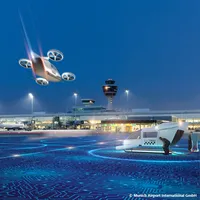Overview
In the context of the ongoing development of Advanced Air Mobility (AAM) concepts, one particular challenge is the integration in the existing airspace structure. The project “AMI-AirShuttle” aims to develop a holistic solution that enables flights of vertical take-off capable air taxis (VTOL) at commercial airports without restricting the existing conventional air traffic. The Chair of Aircraft Design contributes to the project by developing slot-neutral arrival and departure trajectories, as well as evaluating the expected additional air traffic noise in the vicinity of the airport. In further workpackages, the project partners prepare a viable operational concept, design the landing site at the airport (called “Vertiport”), including all necessary ground handling processes, and evaluate the public acceptance and user experience. The project is embedded in the Holistic Air Mobility Initiative, funded by the Free State of Bavaria, and led by Munich Airport International (MAI) and Airbus with the involvement of several partners across research and industry.
Slot-neutral and noise optimal AAM trajectories
For the construction of the arrival and departure trajectories performed at the Chair of Aircraft Design, a multi-step approach is followed. As an intermediary result, this yields slot-neutral base trajectories that are flyable by the considered VTOLs and conform to all separation requirements towards the conventional air traffic. After optimizing the energy consumption and noise exposure of the residents, a set of final trajectories is gained. This approach ensures the highest possible VTOL range, minimal additional traffic noise, and a maximum system throughput.
In the parallel evaluation of the traffic noise, 3-D models of three possible VTOL configurations are used to perform numerical simulations of their noise characteristics. These, in combination with the base trajectories, are then used to calculate the noise levels on the ground. Finally, auralization techniques and a subject study are employed to determine the perceived annoyance of the additional traffic noise.
The results will also be analyzed with regards to necessary changes to International and European regulation, developing concrete suggestions in the process. Altogether, the project constitutes the first basis for investigating the real-world integration of AAM solutions at different airports while measuring the factors system throughput and vehicle range, vital to the success of such solutions, using operational parameters of higher-level traffic systems. The AMI-AirShuttle project therefore is an important contribution to the development of concrete operational concepts for AAM-traffic at commercial airports as well as the corresponding regulatory framework.
